
 |
|
| STRUCTURE | |
| Summary | SFR |
| Introduction | Performance |
| Purpose of clay isolation | Longevity |
| Construction of clay isolations | References |
| FIGURES & TABLES | ||
Fig. 1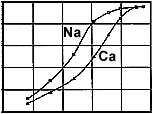 |
Fig. 2 |
Fig. 3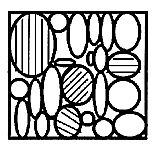 |
Fig. 4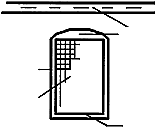 |
||
Tab. 1 |
Tab. 2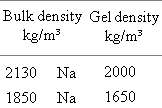 |
Tab. 3 |
A repository (SFR) for medium- and low-level waste was constructed at Forsmark, about 150 km north of Stockholm, about 10 years ago (Pusch 1994). The medium-level waste is stored in a concrete silo with 25 m diameter and 50 m height, the silo top being located about 50 m below the bottom of the Baltic Sea, which is about 5 m deep in the area. The about 2 m wide space between the silo and the wall of the blasted rock cavern is filled with bentonite powder. The silo rests on a very dense 10/90 bentonite/sand fill with low compressibility and expandability. The paper describes the major features of the clay barriers of the repository.
Interlamellar water is strongly associated with cations and, for some
ion species, with the crystal lattice. 0-3 hydrates are present in Na and
Li montmorillonite and 0-2 when Ca is the adsorbed cation.
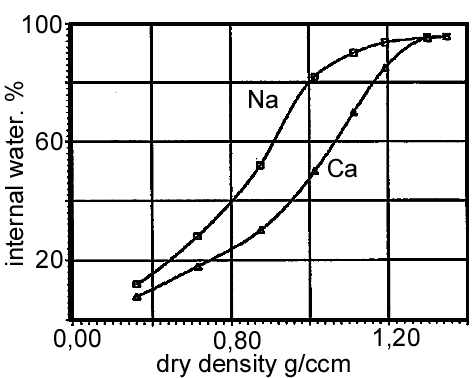 |
Fig. 1: Content of interlamellar water in montmorillonite with Na and Ca as adsorbed cation in percent of total porewater content. |
The resulting buffer microstructure is a system of randomly oriented, anisotropic, deformed air-dry Na bentonite grains with narrow channels penetrating the clay matrix or forming "dead ends" (fig. 3).
On hydration, the stacks of lamellae in the grains expand in the crystallographic c-direction to host up to 3 interlamellar hydrates by which some channels are totally compressed. In open channels smectite stacks are exfoliated from the grains and form clay gels with a density that is a function of the bulk density. It is the properties of these gels that determine the hydraulic and gas conductivities as well as the ion diffusion transport capacity. Table 1 gives typicalmicrostructural data. Selection of buffer type, geometry and density will be based on a number of criteria, the major ones being:
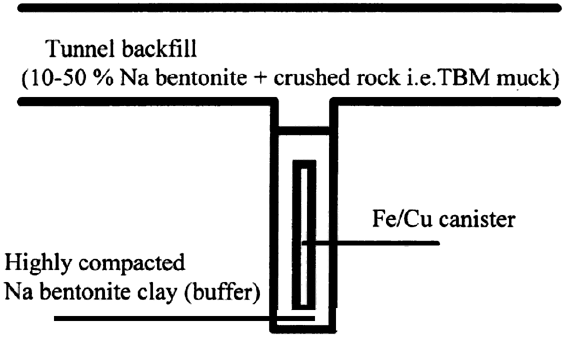 |
Fig. 2: Schematic illustration of the KBS3 concept. The tunnels are a few hundred meters long. The spacing of the deposition holes is about 6 m. |
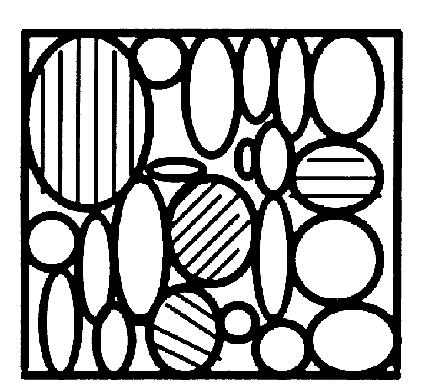 |
Fig. 3: Schematic picture of MX-80 powder grains which have a diameter ranging between 0.01 and 1 mm. Each grain contains billions of 10 Å montmorillonite lamellae. |
 |
Tab. 1: MX-80 reference clays. The channels are filled with clay gels with a density that is related to the channel size. |
Three clay barriers are used for isolating the silo from the surrounding rock: A 1.5 m thick bentonite/ballast bottom bed that carries the load of the silo, a bentonite fill in the 2 m wide space between the silo and the walls of the rock cavern, and a bentonite/ballast top filling (Pusch 1994). The latter has not yet been designed while the other two are on site since 1987. The selection of clay materials and application techniques and design principles were based on the following major criteria:
The settlement and conductivity criteria are contrary in the sense that a low compressibility and expandability imply a high density but a low smectite content, while a low hydraulic conductivity requires a high smectite content (Pusch 1994). The optimum composition was concluded to be a mixture of 10 % Na bentonite and 90 % graded granitic ballast (glacial origin) thoroughly mixed (dry mixing) and applied in 0.3 m layers. They were compacted by 10 runs of 2 and 3.5 ton vibrating rollers. Frequent determinations of the density were made in the course of the construction of the 1.5 m thick bed and showed that the minimum dry density (ratio of mass of solid substance and total volume) was 2050 kg/m³. Testing of the compressibility was made in the laboratory and by plate loading on site from which the E-modulus was evaluated. Analytical calculations gave a settlement of the filled silo of about 3 cm in the first 20 years. The hydraulic conductivity was measured on samples exposed to hydraulic gradients of 30-100, using distilled water and strongly brackish calcium-dominated Forsmark ground-water (11000 ppm salt). It was found to be 1.2E-10 m/s at maximum, i.e. about one order of magnitude lower than the conductivity of the surrounding rock.
The postulated criteria with respect to compressibility and hydraulic conductivity were thus fulfilled. No checking of the conductivity in situ can be made but the settlement of the silo has been recorded for almost 10 years and the result is that the silo, which is now filled to approximately 1/3 of its total volume, has settled by about 1.4 cm.The settlement takes place according to a log time creep law and extrapolation gives a settlement after 500 years of 3-4 cm considering buouyancy efffects, which is acceptable.
The wall filling
Preceding large scale tests had shown that the most economic, technically feasible way of filling the 50 m high and 2 m wide space between the silo and the rock would be to fill a hopper with granulated bentonite and move it along the upper edge of the silo while emptying it through a 6" flexible tube that reached down to the bottom or already applied fill (Pusch 1994). This technique was applied and uniform filling was obtained by continuously moving the open end of the tube. No compaction was made since the bulk density had to be relatively low for satisfying the load design criteria specified for the concrete silo. The average dry density of the 7000 ton fill was predicted to be about 1020 kg/m³ in the lowest 20 m interval, 1000 kg/m³ between 20 and 40 m from the bottom and around 980 kg/m³ in the uppermost 10 m interval. Taking conservative density and electrolyte variations into consideration this would yield a swelling pressure of 0.2-0.5 MPa at the lower end of the filling and 0.05-0.3 MPa at its upper end. The recorded pressure, still with no piezometric component due to the drained conditions, has its highest value 0.08 MPa in the lowest part of the fill. This pressure is hence lower than predicted.
Hydraulic conductivity
The hydraulic conductivity calculated by use of microstructural models
implying gel filling of the intergranular channels, and experimentally
determined for MX-80 in Na form is shown in Table 2.
It demonstrates the relevance of the model and shows how important the
bulk density is for the hydraulic conductivity (Pusch 1994).
 |
Tab. 2: Microstructural data and conductivities for MX-80 in Na form. |
Gas conductivity
The rheological properties of the gel fillings in the microstructural channels determine the "critical gas pressure" and the gas transport capacity (Pusch 1983, 1994). At high bulk density the firstmentioned is approximately equal to the swelling pressure.
Swelling pressure
Smectite clay confined in an oedometer or in deposition holes of a repository
exerts a swelling pressure on the confinement. The pressure is caused by
the hydration potential of the smectite stacks of lamellae (Pusch
1994). The nature of the pressure can be described as partly "osmotic"and
partly "steric". Elastic energy stored at the block compression affects
the microstructural evolution. Table 3 gives examples
of swelling pressure of MX-80 bentonite.
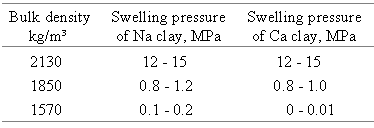 |
Tab. 3: Swelling pressure of MX-80 clay in Na and Ca form.(low porewater salinity). |
General
Two major processes threaten the performance of repository clay barriers:
Time and temperature control this conversion process, which may take place through release of Si from tetrahedral positions and uptake of Al in octahedral positions and subsequent interlamellar uptake of K., or through neoformation of illite by crystallization of heat-released Si and Al in the presence of available K (Nadeau 1986; Pusch 1993. The working model gives negligible changes for the 3000 years long heating period (15-90 °C) and very moderate illitization in the subsequent 100 000 years.
Cation exchange
Exchange from Na to Ca, Cu or Fe causes increase in hydraulic conductivity and drop in swelling pressure except when the bulk density exceeds about 2000 kg/m³ (Pusch 1994).
Silica precipitation
Precipitation of silica under the thermal gradient in deposition holes yields cementation, which produces brittleness and loss in self-healing potential. The practical importance of the process is presently being investigated.
Concrete/bentonite integration
For the required 500 years of performance of the Forsmark repository the loss in mechanical strength of the silo by cement degradation was concluded to be of limited importance as indicated by studies of natural analogues and application of a simple but conservative chemical model (Pusch 1982). This model implies that Ca(OH)2 in the cement component of the concrete is dissolved layerwise from the contact surface and inwards and that the dissolved components diffuse away from the contact into the clay without being absorbed. This process creates a concentration gradient in Ca that drives the process. The model is based on the assumption that the solubility of calcium in equilibrium with calcium silicate hydrates is 2E-3 kmol Ca/m³. It shows that 95 % disintegration of the concrete will have taken place in about half the concrete wall, i.e. to 90 cm distance from the clay/concrete contact, in 500 years.
For the clay alteration a simple theoretical approach is to take the major smectite mineral montmorillonite to be characterized by the general pyrophyllite formula (Eq.1) and consider reactions with excess Ca(OH)2 emanating from the concrete. This yields reactions of the type shown by Eq.(2).
Al4 Si8 (OH)4 (1)The reaction product is the zeolite chabazite, but depending on the degree of flushing of alkaline solutions, other zeolites like scolecite, gismondite and analcime may be formed. It is in fact also possible that OH attack may produce Al(OH)4, Mg(OH)2 and SiO(OH)3 or amorphous substances and gel complexes. The matter is under investigation.
Ca(OH)2 + Al4 Si8 (OH)2 > 2 Ca Al2 Si4 O12 · 6H2O (2)
NADEAU, P. H., BAIN, D. C. (1986): Composition of some smectites and diagenetic illitic clays and implications for their origin.- Clays and Clay Minerals, 34, 455-464.
PUSCH, R. (1979): Highly compacted sodium bentonite for isolating rock-deposited radioactive waste products.- Nuclear Technology 45, No.2 (153-157).
PUSCH, R (1982): Chemical Interaction of clay buffer materials and concrete.- SKB Technical Report SFR 82-01. Swedish Nuclear Fuel and Waste Management Co, Stockholm
PUSCH, R. (1983): Gas migration through bentonite clay. SKBF/KBS Technical Report 83-71.- Swedish Nuclear Fuel and Waste Management Co, Stockholm.
PUSCH, R. (1993): Evolution of models for conversion of smectite to nonexpandable minerals.- SKB Technical Report TR 93-33. Swedish Nuclear Fuel and Waste Management Co, Stockholm.
PUSCH, R. (1994): Waste Disposal in Rock, Developments in Geotechnical Engineering, 76. Elsevier Publ. Co.